
One of the federal lawsuits challenging approval of the Vineyard Wind 1 offshore wind project off the south coast of Massachusetts has been dismissed, and the remaining three are based on similar arguments before the same judge.
A group of Nantucket residents challenged the authorization of the 800-MW offshore wind project on the contention that federal agencies that reviewed it performed inadequate environmental assessments. Specifically, they argued that the project could negatively impact whales, including the critically endangered North Atlantic right whale, and degrade air quality.
The plaintiffs are the Nantucket Residents Against Turbines (or ACKRATS, “ACK” being the International Air Transport Association code for Nantucket Memorial Airport) and a founding member of the group, Vallorie Oliver. The judge hearing the matter ruled May 17 that they had not made their case.
Named as defendants are the U.S. Bureau of Ocean Energy Management, Interior Secretary Deb Haaland, the National Marine Fisheries Service (NMFS), Commerce Secretary Gina Raimondo and Vineyard Wind, jointly owned by Avangrid Renewables and Copenhagen Infrastructure Partners.
U.S. District Judge Indira Talwani ruled that the plaintiffs had standing to challenge the approval regarding the project’s potential harm to whales but not on the potential impacts to air quality from vessels constructing the wind farm.
Talwani shot down their arguments one by one in a 52-page ruling and granted the defendants’ motion for summary judgment dismissing the case.
The other three lawsuits before Talwani are based on similar arguments, though some details differ. They each accuse federal agencies and administrators of various failures and violations.
Long History
BOEM awarded a lease to Vineyard Wind 1 on April 1, 2015, and gave final approval to its construction operations plan on July 15, 2021.
The lawsuits began rolling in almost immediately. On July 18, Allco Renewable Energy alleged that the defendants’ legal errors would negatively impact solar qualifying facilities under the Public Utility Regulatory Policies Act in the Northeast.
ACKRATS filed its complaint Aug. 25. Then on Dec. 15, several parties in the fishing and seafood industries filed a complaint saying the defendants disregarded their legal responsibilities with their “unintelligent” pursuit of energy policy goals. As a result, they say, the plaintiffs will have to stop fishing in the Vineyard lease area and be economically ruined.
On Jan. 31, 2022, the Responsible Offshore Development Alliance, a D.C.-based fishing industry nonprofit, filed a complaint saying the defendants failed to comply with numerous statutes and regulations. It noted that the several dozen towering turbines of Vineyard Wind 1 are the first of thousands expected to be erected off the U.S. East Coast.
As part of its study and review process, NMFS concluded construction would not jeopardize the continued existence of the right whale. But it found the project might disrupt the lives of as many as 20 individual whales; fewer than 400 right whales are estimated to exist.
Pile-driving operations are allowed only under certain circumstances in December and not at all in January through April, the period of greatest right whale activity in the area. Other mandated protective measures include trained species observers on-site, acoustic monitoring and a 10-knot speed limit.
BOEM has authorized Vineyard Wind 1 to inflict Level A incidental harassment — involving potential physical injury — on as many as 115 marine mammals during construction through April 30, 2024. These include up to 10 humpbacks, nine long-finned pilot whales, five fin whales, two minke whales and two sei whales, along with 63 Atlantic white-sided and common dolphins. Zero harm is authorized to sperm and right whales.
Level B harassment — involving potential disruption of behavior patterns — is authorized against up to 307 whales of the seven species, as well as 5,753 specimens of the two dolphin species and 845 gray, harbor and harp seals.
The project entails 62 General Electric Haliade-X turbines rated at 13 MW, standing on monopile foundations 1 nautical mile apart from each other and as close as 12 nautical miles from the shores of Nantucket and Martha’s Vineyard.
Construction of Vineyard Wind 1 began in 2022, as did work on South Fork Wind, a 132-MW Ørsted-Eversource Energy wind farm south of Rhode Island. Later this year, one of the two will become the first utility-scale offshore wind project to come online in North America.
“Avangrid commends the efforts of the U.S. Department of Justice, the federal government and the Vineyard Wind 1 project team to defend the nation’s first commercial-scale offshore wind project, and is pleased that the ruling issued by the U.S. District Court acknowledges the rigorous and thorough administrative review that the project underwent over the last many years,” Sy Oytan, Avangrid COO of offshore wind, said in a news release May 18. “Avangrid is proud of its role in launching the offshore wind industry in the United States and bringing enough clean energy to power 400,000 homes and businesses in Massachusetts.”



